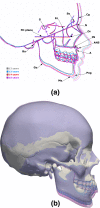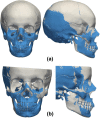A 3D cephalometric protocol for the accurate quantification of the craniofacial symmetry and facial growth
- PMID: 31131023
- PMCID: PMC6525456
- DOI: 10.1186/s13036-019-0171-6
A 3D cephalometric protocol for the accurate quantification of the craniofacial symmetry and facial growth
Abstract
Background: Cephalometric analysis is used to evaluate facial growth, to study the anatomical relationships within the face. Cephalometric assessment is based on 2D radiographic images, either the sagittal or coronal planes and is an inherently inaccurate methodology. The wide availability of 3D imaging techniques, such as computed tomography and magnetic resonance imaging make routine 3D analysis of facial morphology feasible. 3D cephalometry may not only provide a more accurate quantification of the craniofacial morphology and longitudinal growth, but also the differentiation of subtle changes in occlusion. However, a reliable protocol for the computation of craniofacial symmetry and quantification of craniofacial morphology is still a topic of extensive research. Here, a protocol for 3D cephalometric analysis for both the identification of the natural head position (NHP) and the accurate quantification of facial growth and facial asymmetry is proposed and evaluated. A phantom study was conducted to assess the performance of the protocol and to quantify the ability to repeatedly and reliably align skulls with the NHP and quantify the degree of accuracy with which facial growth and facial asymmetry can be measured.
Results: The results obtained show that the protocol allows consistent alignment with the NHP, with an overall average error (and standard deviation) of just 0.17 (9.10e-6) mm, with variations of 0.21 (2.77e-17) mm in the frontonasal suture and 0.30 (5.55e-17) mm in the most prominent point in the chin. The average errors associated with simulated facial growth ranged from 1.83 to 3.75% for 2 years' growth and from - 9.57 to 14.69% for 4 years, while the error in the quantification of facial asymmetry ranged from - 11.38 to 9.31%.
Conclusions: The protocol for 3D skull alignment produces accurate and landmark free estimation of the true symmetry of the head. It allows a reliable alignment of the skull in the NHP independently of user-defined landmarks, as well as an accurate quantification of facial growth and asymmetry.
Keywords: Cephalometry; Craniofacial morphology; Facial growth; Facial symmetry; Phantom study.
Conflict of interest statement
Competing interestsThe authors declare that they have no competing interests.
Figures






References
-
- Swennen GR, Schutyser FA, Hausamen J-E. In: Gwen RJ, Swennen FAC, Schutyser J-EH, editors. Three-dimensional cephalometry: a color atlas and manual. Berlin Heidelberg: Springer Science & Business Media; 2005.
-
- Mish EC. Contemporary implant dentistry. St. Louis: Mosby Elsevier; 2008.
-
- Solaberrieta E, Mínguez R, Barrenetxea L, Otegi JR, Szentpétery A. Comparison of the accuracy of a 3-dimensional virtual method and the conventional method for transferring the maxillary cast to a virtual articulator. J Prosthet Dent Mosby. 2015;113:191–197. doi: 10.1016/j.prosdent.2014.04.029. - DOI - PubMed
Grants and funding
LinkOut - more resources
Full Text Sources
Medical

